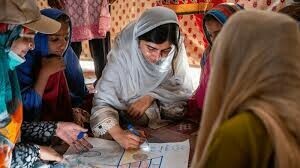KARACHI: A report identifies the Indus Delta, Damb, Pasni, Gwadar and Jiwani as major areas where coastal erosion is fast taking place, mainly due to damming of water upstream and unplanned fish harbours.
It criticises the Defence Housing Authority (DHA), which, has undertaken development projects without considering the consequences on the coastal morphology and possible adverse impacts on the sensitive ecology of the area.
The document, Coastal Erosion in Pakistan: A National Assessment Report, has recently been finalised by experts under a United Nations Environment Programme project, ‘Strengthening the resilience of coastal communities, ecosystems and economies to sea-level rise and coastal erosion’.
The project financed by the Mangroves for the Future initiative is being implemented with the help of the International Union for Conservation of Nature. The World Wide Fund for Nature-Pakistan helped in the report’s preparation.
Highlighting natural factors causing coastal erosion, the report says Pakistan’s coastline being the boundary of the Arabian Sea is under the direct influence of oceanic forces that have severe bearings on the coast.
One of the major forces, the report says, is the monsoon weather system that develops due to a differential heating regime. The differential heating between the Arabian Sea and the surrounding land masses as a result of seasonal movement of the sun causes a north-south pressure gradient that drives the seasonally reversing (monsoon) winds over the North Indian Ocean. Tectonic activities, according to the report, especially along the Balochistan coast also contribute to coastal erosion.
“In Pakistan erosion is a natural phenomenon as the coast changes it position season to season. However, due to human interventions, erosion of coast at populated areas has been evident,” it says.
On human factors, the report highlights various unplanned developments along the coast; this includes the power generation plant (Hubco) located in Kund, Balochistan, which releases coolant water into the Hub river. This process has been eroding the sand, the natural barriers, from the mouth of the river since the plant’s establishment in the early 1990s.
In the Gadani coastal area, a ship-breaking industry has been in existence by beaching various types and sizes of ships perpendicular to the coast. The beaching of ship hinders the sediment transport and causes erosion at the area for the period until the ship is dismantled.
“As a result of development of the fish harbour at Gadani, Balochistan, the water circulation dynamics has been changed and, subsequently, the beach behavior from a stabilised to an eroding beach. The erosion in the area is so severe that seawater is frequently inundating the coastal settlements,” it says.
The construction of a fish harbour in Damb located at the bank of Miani Hor lagoon in Balochistan has resulted in massive erosion causing huge losses to property of fishing communities. Although the fish harbour could not be completed due to erosion around the village and accretion within the harbour basin the abandoned structure is still causing a severe loss of sediments from the populated area of Damb village, the report says.
A similar type of erosion has taken place at Pasni, where a fish harbour was constructed in 1988 that resulted in obstruction to the long-shore current. The stoppage of sediment movement towards Shadi Khore has caused erosion in Pasni and seawater is frequently flooding Pasni town.
The situation, the report says, is no different in Gwadar and Jiwani, parts of Balochistan. The erosion at east and west to the Gwadar headland has been evident due to unplanned construction of fish harbours at Pishukan that is creating hindrance in the sediment movement towards Gwadar East bay causing deficiency of sediment. The main road along the East bay coast is being eroded at many places along the coast resulting in the need for continuous road repairs.
In Jiwani, the construction of the breakwater wall is causing massive erosion at the eastern part of Jiwani town. The breakwater that was constructed to give sheltered area has, in fact, created refracted waves from the breakwater wall.
On Karachi, the report says, the DHA under its Waterfront Development Project intruded 300 metres seaward into deep water and about seven kilometres along Clifton beach. The reclamation hindered the littoral transport along the coast and deposition of sediment during the monsoon. Consequently, Clifton beach has turned into a dangerous beach due to erosion of the intertidal zone and annually there is some human casualty at Clifton beach.
What was low-lying intertidal zone 20 years ago has now been turned into expensive residential areas by the DHA, it says. Hence, Gizri creek and Korangi creek have been narrowed with the reclamation for real estate development.
“Even the area which faces the open sea has been encroached by construction of dyke for reclaiming the land. Since development is relatively new, no significant erosion is witnessed but there are areas that are facing erosion problems. The Bundal Island and its environment are facing severe erosion and sediments are moving towards Korangi creek channel to fill it up. Erosion in the west of Karachi harbour at Kakapir is also observed,” it says.
The report also takes note of the havoc played by sea intrusion and the Left Bank Outfall Drain. Damming of the water upstream has reduced river discharge and owing to ingress of high energy waves, erosion activities are amplified manifold resulting in seawater inundation during storm surges or cyclonic activities in the area.
“The erosion in the delta is so massive that in some places, local communities had to migrate. The localities that are facing erosion in the Indus Delta are Shah Bundar, Jati, Kharo Chann in Sujawal district and Keti Bundar, Ghorabari in Thatta district. Massive levels of erosion are also taking place in Badin district as a result of the Tidal Link Drain linking the LBOD with the Indus Delta Creek for draining the water,” it says.
The report calls for a coastal management plan and plantation of mangroves in areas receiving seasonal flow of freshwater.
“If the coastal zone is managed in a scientific manner by conducting hydrodynamic surveys before embarking upon any coastal project or a project which has influence on the coast then it will become a coastal area with socio-economic value,” it concludes.












































